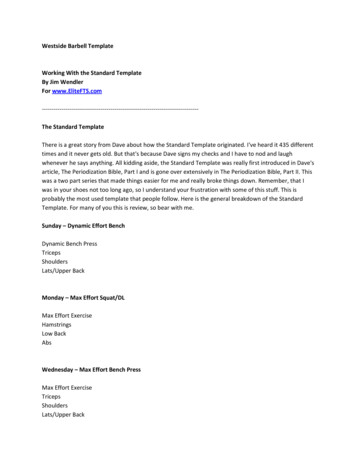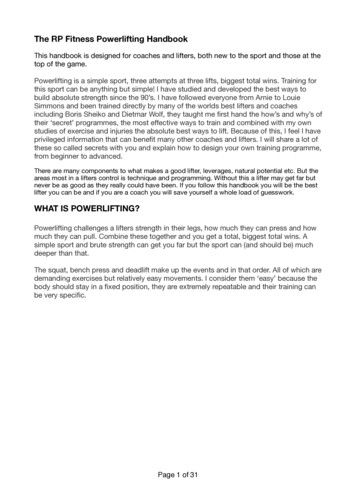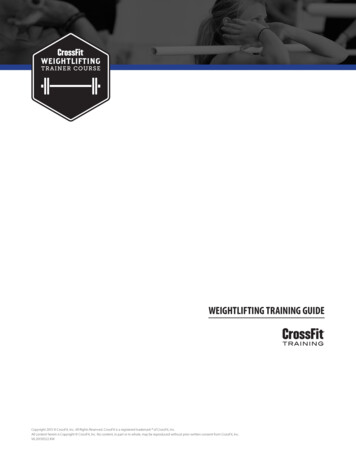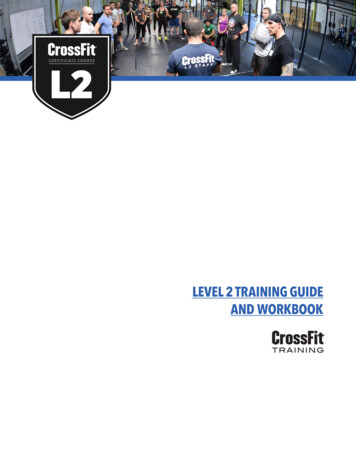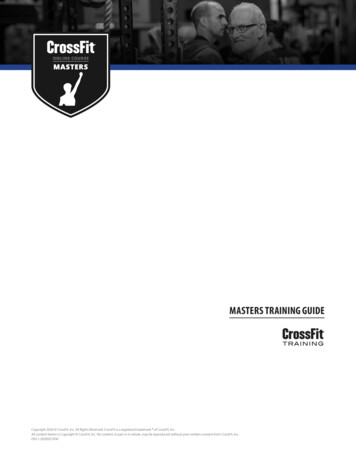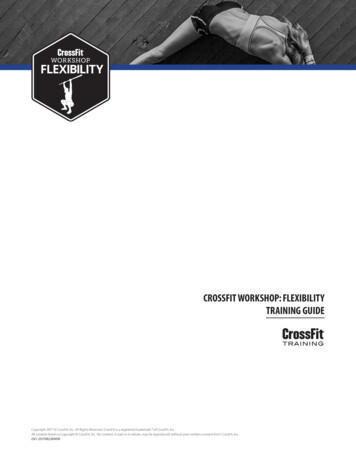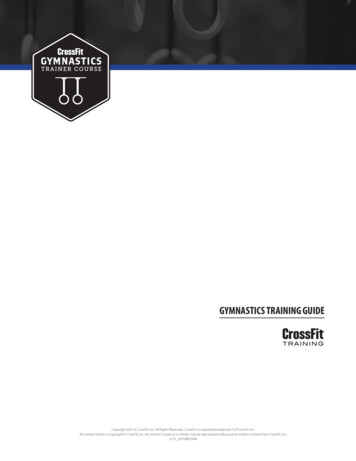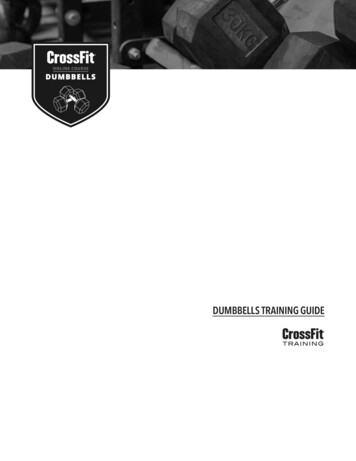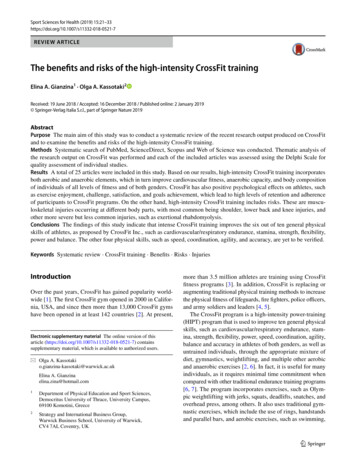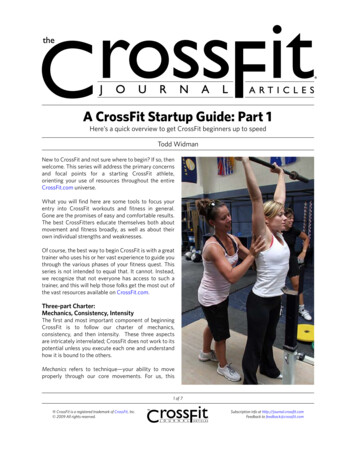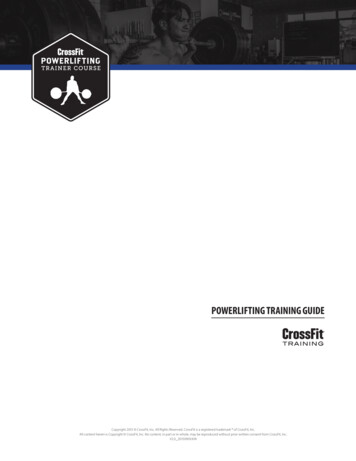
Transcription
POWERLIFTING TRAINING GUIDECopyright 2015 CrossFit, Inc. All Rights Reserved. CrossFit is a registered trademark of CrossFit, Inc.All content herein is Copyright CrossFit, Inc. No content, in part or in whole, may be reproduced without prior written consent from CrossFit, Inc.V2.0 20150909.KW
Powerlifting Training Guide TABLE OF CONTENTSTHE WESTSIDE CONJUGATE SYSTEM . . . . . . . . . . . . . . . . . . . . . . . . . . . . . . . . . . 3MULTI-YEAR PLAN . . . . . . . . . . . . . . . . . . . . . . . . . . . . . . . . . . . . . . . . . . . . . . . . . . . . . . 8DYNAMIC AND MAX EFFORT EXAMPLES. . . . . . . . . . . . . . . . . . . . . . . . . . . . . . 11THE PLAN: DYNAMIC SQUAT DAYS . . . . . . . . . . . . . . . . . . . . . . . . . . . . . . . . . . . . 15EXAMPLES OF A THREE-WEEK WAVE. . . . . . . . . . . . . . . . . . . . . . . . . . . . . . . . . . 16HOW TO CHANGE VOLUME AT THE SAME INTENSITY ZONE . . . . . . . . . 16THE PLAN: DYNAMIC SQUAT DAYSFOR A 400- TO A 1000-LB. SQUAT. . . . . . . . . . . . . . . . . . . . . . . . . . . . . . . . . . . . . . 17CONTACT . . . . . . . . . . . . . . . . . . . . . . . . . . . . . . . . . . . . . . . . . . . . . . . . . . . . . . . . . . . . . . 202 of 21Copyright 2015 CrossFit, Inc. All Rights Reserved.V2.0 20150909.KW
Powerlifting Training Guide THE WESTSIDE CONJUGATE SYSTEMMany have asked how and why Westside developed the conjugate system.I started training full time in powerlifting in late 1969 after returning from the army. I hadmy first power meet in 1966. What an experience! I lifted along with four future worldchampions: Milt McKinney; George Crawford, who gave me countless tips on squatting;Larry Pacifico; and Vince Anello, who was the deadlifting machine.I asked Vince what helped his deadlift. His reply: “Everything helps my deadlift.” Itsounded vague, but Vince was using the conjugate system, although it was unnamed.George was the squat king. His training was a combination of regular squats, box squats,old Westside style (meaning Culver City, Calif., style), rack squats and good mornings,which contributed to his success. This is the conjugate system, a system of unidirectionalloading that was designed to enable him to squat more.Pacifico, who was a renowned powerlifter in the 1970s and early 1980s, was great ateverything, but his bench was unreal. His bench training was a combination of heavy-dutybodybuilding and lots of triceps work. Larry told me that 75 percent of our bench successwas from the triceps.With their advice, which they gave me freely at meets, and by following the methodologies of the Culver City Westside group, I came up with the Westside conjugate system.Bill (Peanuts) West was the founder of the Culver City Westside Barbell Club. George Frennwas a world record holder in powerlifting and in the 56-lb. weight throw. They had countless special exercises, such as rack pulls, box pulls, high pulls, good mornings, box squatting on boxes of at least three different heights, benching with rubber mats on the chest,floor pressing, rack lockouts, and so forth. Their rotation of exercises was space-age at thetime, which was 1965 to the early 1970s. The system was the conjugate sequence system,although it was not named yet. The training I was doing at the time was influenced byeveryone mentioned above.The only true problem I had was the loading. There were no Soviet secrets being leakedto the United States at that time. The progressive gradual overload system was beingused in the U.S. It was divided into different time periods, or blocks, designed to work ona specific element of training. I am amazed that lifters are still using it today. It’s a deadend street. The young lifters believe it’s a new form of periodization. Maybe they think thepush-button starters on some new cars are also new, but all cars had a starter button inthe 1940s.I was always stronger a week or two after a meet, or a week or two before the meet butvery seldom on meet day. The Soviets had coaches, like Matveyev, who realized there wasa much better method of planning. There has always been controversy over who cameup with wave periodization. Dr. Yuri Verkhoshansky has been credited with the pendulumwave. This was in 1964. Even the renowned Bulgarian coach Abadjiev had a similar plan forwaving volume and intensities.3 of 21Copyright 2015 CrossFit, Inc. All Rights Reserved.V2.0 20150909.KW
Powerlifting Training Guide In 1972, the Dynamo Club had 70 highly qualified weightlifters do an experiment byrotating 25-45 special exercises, including the classical lifts. After the experiments weredone, one lifter was satisfied and the rest wanted more. The system now had a name: theconjugate system.I was training alone and used lots of special exercises for all three lifts to reduce staleness.When you use the same routine over and over, you fail to make progress. This is known asaccommodation. To avoid this, a rotation of exercises, small and large, must be cycled inand out of the plan. I followed this system without knowing it had a name for years—13years to be exact.It was in 1983 when I broke my lower back for the second time. I thought there had tobe a better way. I started to buy books such as the Soviet Sports Review, translated byDr. Yessis, and the Soviet training manuals that Bud Charniga Jr. had translated. Bud toldme that they were textbooks. This is just what I was looking for. They opened my eyes.They are very math- and physics-oriented, with a basis on Newton’s laws of motion. I washooked.I had totaled my first Elite USPF total of 1655 in February 1973. I used no gear, not evenwraps on my knees or elbows or even wrists—just an Olympic weight belt, not a powerbelt. If I wanted to continue to make progress, I had to get stronger, and I had to getsmarter—much smarter. I started all over.First, I used the pendulum wave in 3-week cycles, going from training a heavy and a lightday to a max-effort day where I worked to a max single depending on my level of preparedness. A severe workout can be done every 72 hours, and the second day is devotedto the development of special strengths. It could be explosive strength, commonly knownas the dynamic method.The Westside conjugate system is the best of two advanced training systems: the Sovietsystem, where several special exercises are used to advance the training of superior liftersand athletes, and the Bulgarian system, where near-max lifts are performed every workout. The Westside system is a combination of the two.Science has proven that training at 90 percent or above for 3 weeks will cause physicaland mental fatigue. With the Westside conjugate method, we switch a core barbell exercise each week to avoid accommodation. The wide variety of special exercises will perfectform. The similarities of the Westside conjugate system to the one devised by the Sovietsat the Dynamo Club are obvious. The only difference is the exercises: one system forOlympic lifting and, of course, the other for powerlifting.What I took from the Soviets was the sequence of wave loading. A.S. Prilepin was instrumental in regulating the number of repetitions and sets at a particular intensity zone. Thistruly enlightened me about the importance of calculating volume at each intensity zoneand why it is a waste of time to do too many reps at a given intensity zone. Men such asVerkhoshansky, Bondarchuk, Matveyev, Vorobyev and many more helped lead the way.Westside pendulum-wave cycles last 3 weeks for speed and explosive strength and 2weeks for strength-speed work and utilize several special bars with which to establish4 of 21Copyright 2015 CrossFit, Inc. All Rights Reserved.V2.0 20150909.KW
Powerlifting Training Guide different maxes. But because the reps and sets should remain the same at a given percent,the bar speed at this percent will remain the same.The volume will be different each week due to the difference between bar maxes. Yourfront squat max will be different from your safety-squat-bar max, and of course both willbe different from your max squat. This is to avoid accommodation, which in this case is theconstant overuse of the same loading patterns.5 of 21Copyright 2015 CrossFit, Inc. All Rights Reserved.V2.0 20150909.KW
Powerlifting Training Guide The Soviets and Westside count only all-time records, which amounts to roughly 600 lifts ayear, similar to contest max lifts. The Bulgarian system mandated that the current trainingmaxes were based on that particular day’s strength, equaling about 4,000 lifts a year. Theywere not based on a certain percent. This was determined by Coach Abadjiev’s experiments. They used only six lifts: front squat, back squat, power clean, power snatch, cleanand jerk, and snatch. One had to be well chosen for such a rigorous regimen of training.Westside’s system is to max out on this day according to your level of preparedness. Thismeans that a Westside max effort is the most one is capable of that day. It may not be anall-time record, but it is the most you are capable of on that day, week after week. This isjust like the Bulgarian training with the exception of the number of lifts. They would followthis system 6 days a week. Six maximum lifts were done in the morning. After a 30-minuterest, they would do 6 more maxes on pulling exercises plus 6 max squats, front or back.This was repeated in the afternoon and evening.Westside uses two max-effort days a week, one for the squat and deadlift and one forbenching. Seventy-two hours separate a speed workout and max-effort day for the samelift. Three lifts at 90 percent and above are advised. This is more practical for powerliftingon the basis of using this max-effort system for the last 26 years.A lot of hours and work have gone into perfecting the Westside system. It has morevariety, volume, reps and intensity zones, as well as exercises that literally number in thehundreds. It has been a 40-year odyssey of pain, work and experimentation. Look at ourwebsite and compare our lifts to those of other gyms:– 89 Elites– 17 over 1,000 and 6 over 1,100– 32 who bench over 700, 6 over 800, and 1 over 900– 18 who deadlift over 800– 13 who total over 2,500– 6 who total over 2,600– 3 who total over 2,700– 2 who total over 2,800In addition, I have made a USPF Elite total throughout the time period from February 1973to December 2009, this last time at 62 years old.I hope this explains how the Westside conjugate system was created. I found the right wayto train by observing the smart and resourceful lifters who succeeded compared to thosewho set their own plan and failed and withdrew from Westside.6 of 21Copyright 2015 CrossFit, Inc. All Rights Reserved.V2.0 20150909.KW
Powerlifting Training Guide REFERENCESBomph, Todor. Theory and Methodology of Training (1999)Komi, P. V. (ed.). Strength and Power in Sports (1996)Kurz, Thomas. Science of Sports Training (2001)Lapututin, Nikolai and Oleshko, Valentin. Managing the Training of Weightlifters (1982).Siff, Mel. Supertraining (2004)Starzynski, T. and Sozanski, H. Explosive Power and Jumping Ability for all Sports (1982)Viru, Atko. Adaption in Sports Training (1995)Yessis, M.; Taubo, R. Secrets of Soviet Sports Fitness and Training (1987)Zatsiorsky, V. M. Science and Practice of Strength Training (1995)Zawieja, Martin. Periodization of Training for a Methodical Development of Performance inOlympic Lifting-Bundesleague (1988)7 of 21Copyright 2015 CrossFit, Inc. All Rights Reserved.V2.0 20150909.KW
Powerlifting Training Guide MULTI-YEAR PLANRenowned sports scientist A. S. Medvedyev wrote a text called A System of Multi-YearTraining in Weightlifting (1986), translated by Andrew Charniga, Jr. It presents a systemto train for and compete in the Olympics. Of course, there is much information abouttraining of all respects and how to achieve results at the correct time in a long-term plan.Someone once said, “When you fail to plan, you plan to fail.”Another highly esteemed sports scientist, Tudor Bompa, wrote several books on all subject matter including long-term periodization. In Bompa’s book Theory and Methodologyof Training (1997), he discusses training of many lengths of time. The Greek Philostratus,an ancient scholar, proposed a four-day system, referred to as the “Teter system.” Mensuch as Bompa, Medvedyev and the late Y.V. Verkoshansky, as well as others such as theBulgarians Felix Meerson and Hiden, had much to do with the short- and long-term planning of the Bulgarian weight-training system (Enver Turkileri, 1997).Long-term planning must also address not only adaption but also restoration and howto avoid accommodation. If you read the book Adaption in Sports Training, a weekly planturns into a monthly and then a yearly plan, and then, of course, a multiple-year plan.By 1983, I had been participating in powerlifting for 27 years, but I had no formal plan; myplans or dreams turned into mostly nightmares. I realized that the key to success was partphysics, part biomechanics, and very importantly mathematics. Here, I present a longterm plan that has passed the test of time. Dave “Neutron” Hoff has used this plan sincehe was 14 years old with a 400-lb. squat. At 19 years old he had a 1005-lb. squat. Now at 22years old, he has a 1075-lb. squat and a total of 2750 lb. at 260 body weight.All my methodologies came from the former Soviet Union system and their highlyrespected sports scientists and coaches. The strongest lifters lift the heaviest weight mostoften. I don’t mean lifting 20 lb. heavier than their training partners on max-effort day buton the dynamic day. Many people with a small grasp of training can’t understand this. Butthis is simply math, as outl
Copyright 2015 CrossFit, Inc. All Rights Reserved. V2.0_20150909.KW Powerlifting Training Guide In 1972, the Dynamo Club had 70 highly qualified weightlifters do an experiment by rotating 25-45 special exercises, including the classical lifts. After the experiments were done, one lifter was satisfied and the rest wanted more. The system now had a name: theFile Size: 450KBPage Count: 21


